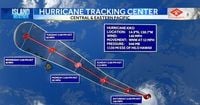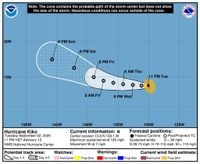On the morning of September 5, 2025, the National Hurricane Center (NHC) confirmed that Hurricane Kiko had surged back to Category 4 strength, churning over the open waters of the Eastern Pacific with maximum sustained winds reaching 140 mph. As the storm inched closer to the Hawaiian Islands, state officials and residents alike found themselves on high alert, bracing for a potentially significant impact next week.
According to the NHC, Kiko was located less than 1,065 miles east-southeast of Hilo, Hawaii, moving west-northwest at about 10 mph. The storm's hurricane-force winds extended outward up to 25 miles from its center, while tropical storm-force winds reached as far as 80 miles. Although the storm's exact trajectory remained uncertain, its strengthening and proximity to Hawaii prompted a swift response from local and state authorities.
By Friday afternoon, acting Governor Sylvia Luke declared a state of emergency for all of Hawaii, effective immediately and set to continue through September 19 unless extended or canceled earlier. The emergency proclamation, as reported by The Maui News, activated measures to protect public health, safety, and welfare from the potential threats of tropical storm-force winds, heavy rainfall, and high surf associated with Kiko. "To ensure the safety and preparedness of our communities, the state and counties will stand ready to mobilize resources to clear debris, secure infrastructure and respond quickly to any possible damage caused by the storm," Luke said. She urged both residents and visitors to stay informed, follow official guidance, and prepare as needed.
As Kiko continued its west-northwest march, meteorologists anticipated that the hurricane would maintain its intensity for another 12 to 24 hours. The NHC noted the storm's annular structure, which can allow hurricanes to resist weakening longer than typical systems. However, forecasters expected Kiko to encounter cooler waters, dry mid-level air, and increasing wind shear by Sunday, likely triggering a gradual weakening as it approached the islands.
Despite the anticipated weakening, the threat to Hawaii was far from negligible. The U.S. Coast Guard warned that some Hawaiian Islands could experience life-threatening surf and rip currents as early as the end of the weekend. Swells generated by Kiko were expected to begin reaching the Big Island and Maui by Sunday, September 7, with surf heights possibly breaching High Surf Warning levels late Monday into Tuesday. The National Weather Service in Honolulu echoed these concerns, projecting that east-facing shores would see steadily rising surf from Sunday through early next week, with the potential for dangerous conditions depending on Kiko's track and intensity.
AccuWeather experts weighed in as well, predicting that impacts to Hawaii could begin by the middle of next week. Flooding downpours, mudslides, gusty winds capable of causing power outages, and strong surf were all on the table. "Kiko is forecast to intensify into a major hurricane later this week as it continues tracking west toward Hawaii," said Alex DaSilva, AccuWeather's lead hurricane expert, in a statement reported by USA TODAY. "The storm is expected to lose wind intensity over the weekend. If Kiko continues advancing toward Hawaii, it could bring some wind and rain impacts to the islands next week."
As of Friday afternoon, no coastal watches or warnings were in effect for Hawaii. Nevertheless, officials advised everyone in the state to keep a close eye on the storm's progress. The NHC emphasized that it was still too early to determine the exact locations or magnitude of potential impacts, but the possibility of hazardous conditions warranted vigilance and preparation.
Local governments, especially in Maui County, responded proactively. County departments were upstaffing crews, preparing vulnerable areas, and ensuring that critical infrastructure was ready for any eventuality. The Maui Police Department announced plans to station officers at major intersections in case of power outages, while the Department of Public Works completed debris removal at key basins and cleaned drains and culverts across the county. Temporary stop signs were also being readied to convert traffic signals into four-way stops if needed.
The Department of Parks and Recreation prepared facilities to serve as emergency shelters, and the Maui Emergency Management Agency (MEMA) urged residents to be "Two Weeks Ready." This means ensuring every household member, including pets, has enough supplies—such as one gallon of water per person per day, shelf-stable food, and necessary medications—to last at least 14 days. MEMA also recommended assembling go-bags with three days' worth of essential items for each person and pet in case of a sudden evacuation. Residents were encouraged to download the Genasys Protect app for live evacuation zone updates and to sign up for MEMA alerts.
The U.S. Coast Guard, for its part, advised mariners and beachgoers to secure boats and paddlecraft, remove loose items from vessels, and stay off the water due to hazardous conditions. Mariners were urged to monitor VHF-FM channels for updates and to heed all weather warnings and advisories. The Coast Guard also reminded the public not to use social media to report life-threatening emergencies, but to call 911 instead for immediate assistance.
Meanwhile, the broader Pacific basin was seeing heightened activity. Hurricane Lorena, another storm in the region, was threatening northwestern Mexico with heavy rainfall, while the NHC was also tracking a developing tropical wave in the Atlantic with a high chance of forming into a depression over the coming days.
Back in Hawaii, the sense of urgency was palpable but measured. The state's recent history with tropical cyclones—many of which have veered away or weakened before landfall—has taught residents and officials not to take any chances. The rugged terrain of the Big Island, for instance, has been known to disrupt the paths of approaching storms, sometimes causing them to slow down or shift direction. However, as the NHC cautioned, a track slightly to the left of the official forecast could bring Kiko closer to the Big Island, increasing the risk of direct impacts.
As the weekend approached, the message from emergency managers, meteorologists, and local leaders was clear: stay informed, prepare for the worst, and hope for the best. The next several days would be crucial in determining whether Hurricane Kiko would pose a direct threat to Hawaii or spare the islands another brush with disaster. For now, all eyes remain on the Pacific, with communities ready to respond to whatever the storm may bring.

